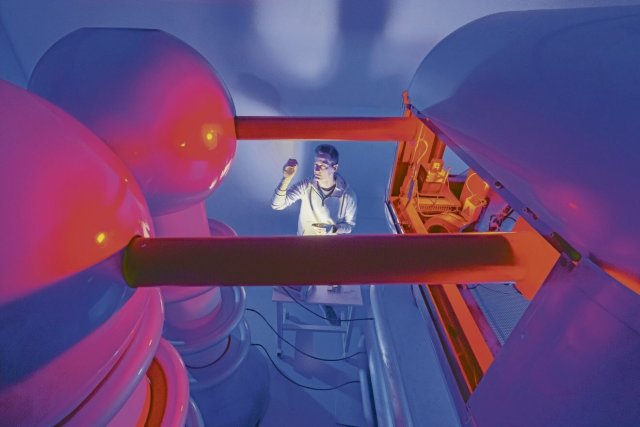Various types of nanowires are being developed at the Institute for Solid State Physics at the Friedrich Schiller University in Jena.
Photo: Jens Meyer/University of Jena
In the future, electronics will become lightning fast with the help of light signals. Tiny nanowires are intended to make integrated optoelectronic components possible. To this end, their sometimes surprising luminescence behavior is currently being investigated.
Nanowires are among the most exciting candidates for new types of electronics. Strictly speaking, it should be called optoelectronics: Conventional electronic components are slowly reaching their physical limits. In the future, light signals will not only ensure the long-distance transmission of data – as is already the case via fiber optic cables in the global Internet. Light pulses are also intended to boost the computers themselves, as they can be clocked extremely quickly. But this also requires correspondingly fast optoelectronic components that convert electrical signals into light signals and vice versa.
And this is exactly where nanowires come into play. These are extremely thin wires that are made to grow on a substrate using special processes. “Typically, nanowires are used whose diameter is in the range of the wavelength of light, i.e. 50 to 500 nanometers,” says Carsten Ronning, Professor of Solid State Physics at the Friedrich Schiller University Jena. A nanometer is a billionth of a meter. Such nanowires are around a thousand times thinner than a hair. At the same time they are about as long as a hair is thick. They can only be observed under special microscopes.
Nanowires have special properties: Because they have dimensions similar to the wavelength of light, they can interact particularly well with light waves. “This is technologically very interesting because it allows you to build tiny lasers or use electrical and light signals at the same time on a so-called optoelectronic chip,” says Ronning. This is still basic research – but a very worthwhile goal is energy-saving and very fast chips.
The researchers from Jena have been working on different types of nanowires for a long time. “For our new experiments that the doctoral students at my institute carried out, we used nanowires made of zinc oxide,” explains Ronning. This is a semiconductor – a material that does not simply conduct electricity like a metal, but is still not an insulator. Semiconductors are used for many purposes in electronics and optical systems, such as LEDs or solar cells.
Implantation of foreign atoms
To tailor the electronic properties of semiconductors, one usually inserts foreign atoms into their crystal lattice. The research team accomplished this using a special device called an ion accelerator. “With our device, we can accelerate atoms from the entire periodic table and shoot them into any other material – including the nanowires that we previously grew using chemical vapor deposition and then applied to a substrate,” says Ronning. In this case, the scientists implanted cobalt atoms into the zinc oxide nanowires. “We chose cobalt because it can function as a light center in this semiconductor,” says the researcher. If you excite the cobalt atoms with X-rays, for example, they begin to glow in visible light.
However, conventional X-ray sources are not sufficient to examine this lighting behavior – known as luminescence – in more detail. “With our basic research, we are trying to understand the interaction of the implanted atoms with the nanowires and with external energy sources such as X-rays,” says Ronning. Now the cobalt atoms are not evenly distributed in the nanowires, but rather form different dense groupings. That’s why you need an extremely sharp and at the same time intense X-ray beam with which you can scan such nanowires step by step. The best X-ray source in the world that currently meets these criteria is the ESRF synchrotron in Grenoble.
Surprising luminescence
Die Results The analysis with the ESRF was – as is sometimes the case in basic research – quite a surprise for those involved. The X-ray pulses at the ESRF are not only extremely brilliant, but also very short, meaning that a very high time resolution can be achieved. The team was now able to measure two different decay times for the cobalt light centers: a longer one of eight nanoseconds and a short one of just one nanosecond – i.e. just a billionth of a second.
“The longer decay time of eight nanoseconds was already known for this material,” says Ronning. However, the short duration of just one nanosecond is a completely surprising luminescence behavior. The original goal of the research work was to develop, build and test the entire complex measuring apparatus with this material. “That’s why we were of course very pleasantly surprised that we were able to uncover new secrets from this material system,” says Ronning.
The measurement result was not theoretically predicted at all. “Our assumption is that the short decay time is caused by the cobalt atoms in the material being directly excited,” explains Ronning. Normally, the entire material is excited, and only the interaction – for example through energy transfer processes – of the semiconductor with the luminescent dye then causes it to glow.
Apparently the light centers can also be stimulated directly. “We cannot yet say whether and how this can be exploited technologically,” says the scientist. But since the measurement setup works so well, the team now wants to use it to examine numerous other materials.
Become a member of the nd.Genossenschaft!

Since January 1, 2022, the »nd« will be published as an independent left-wing newspaper owned by the staff and readers. Be there and support media diversity and visible left-wing positions as a cooperative member. Fill out the membership form now.
More information on www.dasnd.de/genossenschaft
